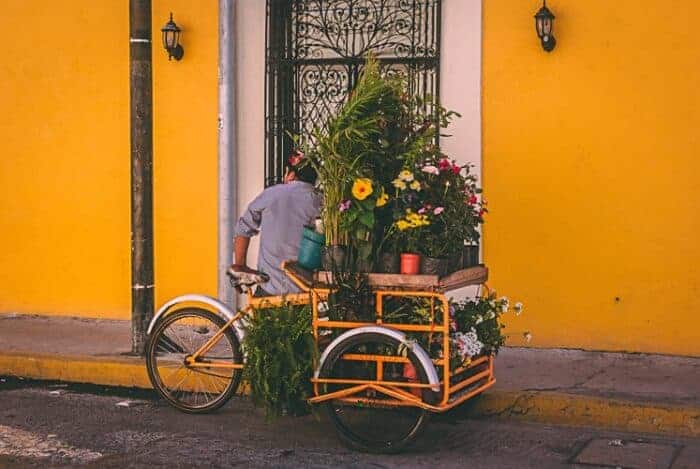Retirement in Mexico is extremely popular with Americans, Canadians, and other Expats across the globe. And it’s no wonder! The low cost of living, great weather, natural beauty, and proximity to the U.S. make Mexico an ideal destination.
If you’re looking at Mexico for retirement, here’s everything you need to know, including the best places to retire in Mexico.

Is retiring in Mexico a good idea?
Yes, especially if you’re coming from the U.S.A., Europe, or Canada. There are 5 great reasons to retire in Mexico:
1) Mexico is cheap
Expect to pay about half of what you would in the States for your monthly budget. Of course, this depends on where you decide to settle. A lovely apartment in Mexico City could cost you a little over USD$600. You’ll also save on utilities, public transportation, and medical care, which are much less expensive. Many retirees find they can live quite comfortably on $1,500 or less a month with all expenses included.
For more details, please check out our Mexico Cost of Living guide.
2) Easy immigration options
Obtaining a permanent or temporary resident visa is possible for many retirees if you can prove you have enough monthly income. Plus, since the country is now using UMA to calculate financial solvency (more on that below), it is easier to qualify. Most retirees enter Mexico earning a pension or annuity and with no intention of working. Because you’ll be engaging in non-remunerative activities, you may be eligible for permanent resident visa status right away. Read more here for a comprehensive explanation of visa requirements.
Obtaining a permanent or temporary resident visa is possible for many retirees if you can prove you have enough monthly income. Plus, since the country is now using UMA to calculate financial solvency (more on that below), it is easier to qualify. Most retirees enter Mexico earning a pension or annuity and with no intention of working. Because you’ll be engaging in non-remunerative activities, you may be eligible for permanent resident visa status right away. Read more here for a comprehensive explanation of visa requirements. A tourist visa is also not required by citizens of the US, UK, Canada, the Schengen region, and other South American countries. Expats can easily enter visa-free to get a taste of the Mexican lifestyle before they make the big move.
3) Variety of cities to choose from
Mexico is a big country, and Mexico City isn’t your only option!! This scale means you have a lot of choices for where you want to live. You may enjoy a quiet coastal life, a vibrant city life, or a relaxed life in the mountains. It also means you’ll have plenty of places to travel around to and explore once in the country. If you’re not into beach towns, you can head to cities with milder summers, like San Miguel de Allende.
4) The weather
The climate is a big draw for visitors of all ages. Retirees, in particular, appreciate the sunny and warm weather they can depend on nearly all year long. Those who want more heat should look at coastal regions and those at lower elevations like Tulum. Those who want more consistent mild (but still lovely!) weather should look at cities in the high desert like Mexico City.
5) Close to home for Americans and Canadians
Traveling to the U.S. or Canada is much easier (and cheaper) than if you were retiring in Europe. Living in Mexico, you’ll still be able to see friends and visit family back home regularly. And maybe they’ll be more likely to visit you!
The short trips are a bonus if you are splitting your time between your home and Mexico.
How much money do you need to retire in Mexico?
How much money you’ll need depends on where you live and what kind of lifestyle you lead. However, most retirees find they can live very comfortably for about half as much as in the United States or Western Europe. And this includes extra luxuries like house cleaners and gardeners.
Additionally, Mexican residents over the age of 60 receive an INAPAM card (Instituto Nacional para las Personas Adultas Mayores) which further reduces costs. This national senior citizen organization provides discounts on many items.
Seniors will receive reduced airfares, bus tickets, medical services, and admission fees to museums, concerts, and other cultural events. And, if you’re a homeowner, you can also sometimes get discounts on your property taxes.
Mexico Healthcare
Most Expats who retire to Mexico take out private health insurance. This allows you to access excellent private healthcare professionals available to private insurance customers.
We recommend purchasing international health insurance. As well as enjoying coverage in Mexico and when you travel abroad, your experience with the private health system may be smoother.
To get quotes for international health insurance, click the button below. You then fill out the form, and you will receive quotes and plan information from two or more of the following companies that best suit your needs.
Mexico Retirement Visa – Rentista / Pensionado Visa
Mexico issues both temporary and permanent residency retirement visas (Rentisa or Pensionado.)
The requirements are pretty simple. You need to show you can support yourself while living in Mexico. However, if you don’t think this immigration permission is right, we have more options in our guide to Mexico Visas and Residency.
Different consulates and embassies have slightly different amounts and requirements. The figures below are a general guide – your Mexican Immigration Lawyer will know what you need for your application.
It’s important to note that these income caps are changing. As of 2016, Mexico decided to move from using Minimum Salary (MS) to Unit of Measurement and Updating (UMA) for calculating economic solvency.
In short, UMA requirements are much lower than MS, but not all consulates have made the switch to using UMA (though they should). For example, using MS, the income requirement for permanent residence as a retiree is around $3,700 a month USD.
Using UMA, the figure is closer to $2,300. The UMA requirement for a temporary residence permit is only around $1,400 a month.
You generally will apply in your home country at the closest consulate. If this is your case, you should check with a Mexican Immigration Lawyer to see which figures your consulate accepts.

Temporary Mexico Retirement Visa (from 180 days to 4 years)
There is no age restriction on the Temporary Residence option.
- Employment or pension income of USD$1,400 -USD2,500 per month. OR
- Twelve months of bank statements showing a minimum balance of USD25,000 – USD40,000 at the end of each month.
Also, you should budget an additional USD $ 600 – USD $ 750 per dependent on top of the amounts above.
Permanent Mexico Retirement Visa (Indefinite leave to remain)
You must also be more than 64 years old to apply for this option. And, if you don’t have the required amounts, you can enter on a Temporary Visa and change your status in the future.
- Pension income of USD$3,000 -USD3,500 per month. OR
- Twelve months of bank statements showing a minimum balance of USD130,000 – USD140,000 at the end of each month.
Also, budget an additional USD$600 – USD$750 per dependent on top of the amounts above.
The Mexico retirement visa does not allow you to work automatically. However, you can apply for a Mexico Work Permit once in Mexico.
Retire in Mexico on Social Security
Using the UMA requirements, it’s entirely possible to retire and live in Mexico using only US Social Security (SS) payments. The average SS payment is $1,430, so many US retirees will meet the lower UMA income requirements.
Also worth noting is that most retirees receive health insurance through Medicaid, which does not offer coverage outside the United States. Because of this, you’ll need to explore your health insurance options. We have written a guide on how to choose the best value international insurance – please check out our Expat Health Insurance guide.
You can also speak to our recommended health insurance broker. They will help you compare plans, answer your questions, and find the best-suited insurance plan for you. It doesn’t cost you any more to use a broker.
Does Mexico tax retirement income?
In general, you should only pay taxes once on your retirement income. Depending on your tax residency, this may be in Mexico or in your home country. Mexico has a double taxation agreement with the U.S., UK, Ireland, Canada, and other European countries.
These agreements mean that although you will have to pay taxes on retirement or investment income, you won’t have to pay twice. Before you move to Mexico, check with an accountant in your home country to understand what you’ll need to do.
Likewise, you should find an accountant in Mexico to help you file your taxes and avoid costly mistakes. Many offer services in English.
Best places to retire in Mexico
Tulum
Tulum is on the Riviera Maya on the Caribbean coast. Over the last couple of decades, this gem has grown from a small fishing village to a sought-after choice for Expats. It’s not the lowest-cost option out there, but here you’ll find white sand beaches, archeological sites, and a peaceful way of life.
San Miguel Allende
San Miguel has a large population of Expats, making it a welcoming place for retirees. The city is full of history, culture, and the arts to keep you busy for the rest of your years. This colonial highlands town is one of the best places if you want to enjoy Mexico’s rich culture.
Playa del Carmen
Prices in Playa del Carmen are a bit higher than elsewhere in the country. However, this Caribbean coastal resort has gorgeous beaches and fishing, and the international airport in Cancun is only 30 miles away.
Huatulco
Huatulco is on the Pacific coast and is close to the Sierra Madre mountains. This city is unique; it’s an entirely planned community made by the National Tourism Fund (FONATUR) 40 years ago. Huatulco has a village feel with both affordable and luxury accommodations available. It’s also very eco-friendly, with much of its energy generated by wind turbines.
Lake Chapala
Lake Chapala is over 50 miles long, and small towns are dotted along its coast. The most popular are Chapala, Ajijic, and Jocotepec, with the highest concentration of foreigners in the country. There are lots of local English-language entertainment options, and the higher elevation makes the climate more reliably temperate most of the time. The lake estates are among the best Mexican retirement destinations for those wanting to live near a strong Expat community.
Guadalajara
Guadalajara is excellent for the retiree who wants more of an “authentic” Mexican experience. You’ll find fewer Expats here than in places like Lake Chapala or Mérida. While it is a big city with plenty of culture and entertainment offerings, living here is also very affordable. Plus, you’ll encounter much more Spanish than English in the streets and markets here. Think of it as free language lessons, and if you learn a few words, it will go a long way!
San Felipe
San Felipe is a booming Expat retiree location and only a two-hour drive to the U.S. border on the Baja Peninsula. This city is one of the best places to retire in Mexico for those traveling back and forth from the United States. It still has that laid-back Mexican lifestyle but is less of a tourist town than nearby Rosarito.
Puerto Vallarta
This Jalisco town is found on the Pacific Ocean’s Bahía de Banderas. Puerto Vallarta is a well-established tourist town with a bustling economy. This development means that there is no shortage of facilities and entertainment for retired residents. And, you can shop till you drop for local and imported clothes and goods. What’s more, Puerto Vallarta is known as a safe spot for Expats and locals alike. Crime rates have been consistently low and have declined even more in recent years. Although it is in the Mexican hurricane area, the Bay protects Puerto Vallarta from the worst of the weather.
Cheapest places to retire in Mexico
If you’re looking for the cheapest places to retire in Mexico, try Ajijic, Puebla, or Merida. These options are ideal for those on a fixed pension or Social Security.
- Ajijic’s required budget could be 40% to 50% of what it would be in the United States. Plus, being on Lake Chapala, you’ll be surrounded by other Expats like yourself.
- Puebla is a short drive from Mexico City, so you’ll always have quick access to Mexico’s biggest city. In fact, Puebla itself is Mexico’s fourth-largest city, and the historic city center offers much to those who spend time locally. It is safe, picturesque, and one of the cheapest cities in Mexico for retirees.
- Mérida, the state capital of Yucatán, with beautiful architecture, is a colonial gem. The town is close to the coast and also has many affordable places to rent or buy. It’s also considered the safest city in the country and a new favorite for many retiring from abroad.
Retiring In Mexico Pros And Cons
Pro: Mexicans are Friendly and Welcoming
As an Expat from a foreign country, Mexico is the perfect place to settle down and make new friends because the local community is very warm and welcoming toward foreigners.
Con: Language Barriers
Spanish is the most widely spoken language in Mexico, but there are sixty other languages spoken all over the country. If you can’t communicate in Spanish, you might face difficulties conducting business, dealing with authorities, and befriending people.
Pro: Mexican Culture is Rich and Vibrant
Mexico is one of the best places to retire if you want to experience the country’s vibrant Mexican culture and rich history. Life in Mexico is colorful and fun, from stunning cathedrals and archaeological sites to fun celebrations and delicious street food.
Con: Hard to Navigate Systems with Bureaucracy
Expats may find the bureaucracy and red tape in Mexico overwhelming as it slows down administrative processes and complicates them.
Pro: Better Quality of life at a Lower Cost
American or Canadian Expats will be able to afford a more luxurious lifestyle at a lower cost.
Con: Not everything is Affordable
While the cost of living is low, not everything is cheap, especially in Expat havens and tourist-heavy areas. Mexico might not be the best option for Expats from developing countries.
Pro: Universal Public Healthcare and Affordable Private Healthcare
Retirees in Mexico are eligible for universal public healthcare or can choose from various affordable insurance packages to access private medical care.
Con: Public Healthcare Standards are not Always Great
Public hospitals in Mexico may not always provide timely, high-quality healthcare for Expats, especially in rural areas.
How to Retire in Mexico
Thousands of people from around the world are enjoying Mexican retirement life today. Many Americans, in particular, are heading south in search of a better quality of life and a warmer climate. Retiring abroad in Mexico could be the best decision you can make.
Interested in retiring in Mexico? Now you know the requirements, check out our Moving to Mexico guide to get started on your adventure today.
Retire in Mexico FAQ from Where Can I Live
How Much Money Do You Need To Retire in Mexico in 2024?
Expats from high-income countries like Canada and the US find Mexico to have a lower cost of living overall. However, the amount of money you’ll need depends on your lifestyle in Mexico.
Retirees above the age of 60 may also be eligible for Mexico’s INAPAM card, which provides discounts on many utilities, including medical services, public transportation, and entertainment.
How Is It Like Living in Mexico City?
As the capital, Mexico City has a population of nine million people and has more job opportunities than other Mexican cities. This bustling city promises a classic laid-back, comfortable lifestyle with a rich culture, tourist destinations, and world-class cuisine.
What Is the Safest Expat Community in Mexico?
Safe Expat havens in Mexico include:
Puerto Vallarta
Mérida
Lake Chapala
Tulúm
Baja California Sur
San Miguel de Allende
Can I Collect Social Security and Live in Mexico?
Yes, US citizens can utilize UMA requirements to retire in Mexico with their Social Security benefits. Since the average social security payments are worth $1,430, most US Expats can easily meet the minimum income requirements of UMA.









Good day, I am 46 hopefully retiring in the next 10 years. I am thinking of applying for my dual nationality. I have a good idea about where to live (Guanajuato) and how much average for cost of living, but do you have any articles that talk about what would be the recommendation for someone who can take advantage of a dual nationality retiring in Mexico?
Hi Luis. Your citizenship will make retiring to Mexico easy as you’ll not need to apply for a Mexico Retirement Visa. Find out more about what Dual Citizenship is here. All the best, Alastair
I am 85 years old in good health with about $1400USD income/month. I also have about $60,000 in savings. I want to move to Mexico and possibly to a cooler mountainous area with a smaller US population. I speak some Spanish. What’s my first step?
Hi David. Start with our Moving to Mexico guide… it has some great advice on next steps. I’ve sent you an email with some additional advice. All the best, Alastair
Hi, my husband and I are look to retire to Mexico in a couple of years. I’m a permanent resident in the U. S., originally from the UK. Do you know how often I would need to return to the U. S., to keep residency, or would it be better to just apply for US citizenship?
Hi Sharon. Living outside of the US can put your American PR at risk. If you can, having US citizenship will keep open the possibilities of an easy return to the US if that is something you want to keep open as a future option. All the best, Alastair
I’m looking to buy a place as a US citizen and use for vacation, Airbnb and retire there in the next 10 years
Hello
My husband is a Canadian, I am a PR in Canada. We meet all requirements of the ‘retiree’ category.
1- Can we apply for a retiree visa IN Mexico, or do we have to go out to apply?
2- do we have to. apply only at the consulate in Canada, or any country just outside of Mexico?
3- or is there a way we can apply it while in Mexico?
Thanks a lot
Jasmin
Hi Jasmin – you’ll need to start the application process form the Mexican consulate in your country of residence (this will be Canada for you unless you are legally resident in another country) – you can’t start the application process in Mexico. All the best, Alastair
Hello. How long can I come and stay Mexico without a visa? A few months? Ideally I’d like to.rent a nice place for 2 or 3 months a year. Wondering if I’d need a Visa for that time period.
Tks in advance
Hi Rocke – a Mexico visitor’s visa is valid for six months. All the best, Alastair
Is La Paz, BCS, MX a good place to retire? Any information on the cost of living there?
We are interested in all aspects of moving to Mexico. We are 70 and still work part time as a yoga instructor and a church organist. We need to know everything! Banking/ stock transfers to housing – etc
Many thanks
Cindy
My common law wife is 70 and I am 75. We heard that because we draw social security in the U.S. we don’t need other financial proof ?
Nothing on line addresses this issue.
Hi Tom. If your US social security payments reach the minimum threshold, you don’t need any other financial proof. All the best, Alastair